BMW's intentions are to compete on the world stage across all categories. To do so, BMW needs a model in the true entry-level realm—up to now that's been handled by the G650 single-cylinder series. Owing nothing to any previous single in the company's catalog is the new G310R, made in India by TVS and designed as a world bike by BMW engineers in Munich.
Why 300cc? "We wanted to have more than 250cc, because when we started the Japanese firms in this segment like Kawasaki and Honda had a maximum capacity of 250cc," says project leader Jürgen Stoffregen. "We decided that 300cc was likely to be the next step for them, so we decided to go with that capacity even though we had no competitor at that stage with such a model. I was quite pleased when Honda came out with the CBR300R! But we have no plans to make different capacity versions like a 200cc or 250cc variant using the same crankcase design. At the moment this is not even under discussion, because it's a lot of work to launch this model and bring it to market in a new segment for BMW, so we are concentrating all our efforts on this capacity platform."
The G310R's liquid-cooled Euro 4-compliant four-valve engine has a bore and stroke of 80 x 62mm for a capacity of 313cc, and in aiming to offer compatibility with varying fuel qualities, has a relatively moderate 10.6:1 compression ratio. But unlike conventional single-cylinder engines, the G310R motor features a backwards-tilted cylinder, a format pioneered by Cannondale on its MX bikes 15 years ago, then copied by Yamaha on its 2010 YZ450 dirtbike, and now brought to the street for the first time here by BMW. The engine delivers a claimed 34 hp at 9,500 rpm, with a 10,500 rpm limiter, and a stated maximum torque of 21 pound-feet at 7,500 rpm. Wet weight is a claimed 349 pounds with 2.9 gallons of fuel, making the BMW 25 pounds heavier than a KTM 390 Duke.
The G310R sees its cylinder head rotated by 180 degrees so that the 42mm throttle body faces forward, for optimum ram air cylinder filling, as well as an advantageous layout for the bike, with the exhaust running directly backwards. According to Stoffregen, it was an architectural reason that drove this layout. “We wanted to be able to have good stability and easy handling, but also extra weight on the front tire for increased safety in cornering via better grip,” he says. “So for this reason we decided it would be good to position the engine a little bit forward, because then you can also make a longer swingarm, which is good for stability. By rotating the cylinder head to allow you to do this you also have the spinoff bonus of a cooler, straighter charge going to the airbox, and an extra benefit was that for Euro 4 you need a short length for the exhaust pipe, which this layout permits. It’s also nice for BMW to do something different when we are new to this sector, and can find a proper solution which is also individual.”
As a true world bike, the Indian-built G310R carries Michelin tires made in Thailand, suspension from KYB's Chinese factory, and brakes by ByBre (Brembo's Indian subsidiary). The G310R's only major components sourced from European suppliers are the F1-style finger-type cam-followers shared with the S1000RR sportbike, whose cylinder head design the G310R largely copies, the Magneti Marelli engine management system, and the two-channel ABS fitted as standard that's supplied by Continental, who are also responsible for the very comprehensive LCD dash. The displays on this include engine rpm, speed, gear position, total mileage plus twin trips, engine temperature, fuel level, distance to empty, average fuel consumption, average speed, and a clock. That's a lot of info for an entry-level product!
The invitation to join a select group of 30 journalists at BMW’s home city of Munich for an advance ride on G310R delivered much more than just an hour or two of running round the streets of the city, with a brief venture out into the surrounding countryside. Instead, the 140-mile route took us south of Munich into the foothills of the Bavarian Alps, and included a broad range of riding conditions, including a brief spell of highway travel at the homologated top speed of 89 mph, with the tach just nudging the five-digit segment as the small shifter light started flashing. Yet at that engine speed and all others the 313cc single motor felt completely unstressed and, more to the point, totally vibe-free—its single counterbalancer works to perfection.
The BMW exudes a visual level of quality that’s frankly unexpected in such a low cost product manufactured offshore. Only the plastic switchgear looks cut-price – the rest of the G310R components look very BMW, with high quality alloy castings and forged triple clamps, an LED tail light, an exceptionally lustrous paint job, and on this early production model at least, build quality looks good. This is an inexpensive BMW, not a cheap one.
Thumb the starter button, and the engine catches instantly from cold on the auto-choke, then settles to a quite high 1,500-rpm idle—perhaps chosen to rule out any rear wheel chatter on the overrun in the absence of a slipper clutch. The large exhaust canister containing the Euro 4-compliant catalyst whispers rather than booms, though above 5,000 rpm there’s a pleasant rasp from the intake. Clutch action is light and untiring, making riding the BMW in city streets a pleasure—your hand won’t cramp up doing so, though first gear is very low, and obviously chosen for when a passenger is carried (make that plural in India!). You soon find it’s better to start from a stop on level ground in second if you’re on your own, without any need to slip the clutch unduly.
The G310R is a great traffic tool, thanks also to the wide spread of torque peaking at 7,500 revs. The single pulls wide open in top gear from as low as 3,200 rpm without any hesitation or transmission snatch. Then there’s an extra kick of acceleration around 7,000 rpm, and another one at nine grand, so it pays to rev it out. That’s not to say that the power delivery is layered, just that it becomes more urgent the harder you rev the motor. Nice. It’s also pretty economical, with a claimed consumption of 70 mpg.
The G310R’s tubular-steel frame more than lives up to the job of harnessing this power delivery well, and the non-adjustable KYB/Kayaba suspension plays a key role in this. Its fixed settings are well chosen, with much better compliance than you have any right to expect for such budget hardware. The single front disc and its four-piston radial caliper are just about up to the job of stopping the BMW and its solo rider hard from speed, but you must use the rear brake hard as well for panic stops, and you don’t get the feeling there’s much in reserve. It’s exactly the same brake package as on the KTM 390 Duke, where I think it works a little better. Pads, maybe? The BMW feels planted in a straight line yet changes direction very easily, aided by the good leverage from the black-painted handlebar whose grips are pulled back and slightly dropped.
No doubt about it, BMW and TVS have joined forces to produce a motorcycle that’s self-evidently a BMW, but made in India largely to the standards of its Berlin factory. While appropriately priced in Europe—US prices have not been announced—it totally conforms to BMW’s brand identity in terms of performance, manufacturing quality, and styling.











/cloudfront-us-east-1.images.arcpublishing.com/octane/HN7YV3Y4XVCQFE2BSWMYS5F7Z4.jpg)


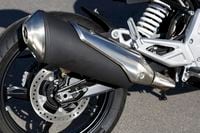
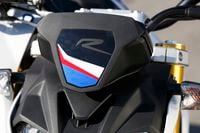
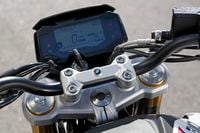
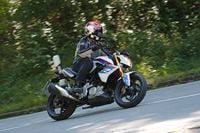

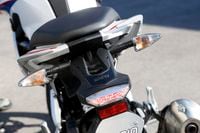

/cloudfront-us-east-1.images.arcpublishing.com/octane/GTCXACQGJ5HAPDTGWUQKDEH44E.jpg)
/cloudfront-us-east-1.images.arcpublishing.com/octane/S35YGSEMEZB4BLTDJTSZPF4GLA.jpg)
/cloudfront-us-east-1.images.arcpublishing.com/octane/5UOT6HPX2JFMRJAX6EH45AR4MQ.jpg)
/cloudfront-us-east-1.images.arcpublishing.com/octane/OKWOJWAKP5EP3OACCRRWPCIX2Q.jpg)
/cloudfront-us-east-1.images.arcpublishing.com/octane/2WF3SCE3NFBQXLDNJM7KMXA45E.jpg)
/cloudfront-us-east-1.images.arcpublishing.com/octane/G4MG6OUCJNBSHIS2MVVOTPX65E.jpg)
/cloudfront-us-east-1.images.arcpublishing.com/octane/IIGGWFOTOJGB7DB6DGBXCCMTDY.jpg)
/cloudfront-us-east-1.images.arcpublishing.com/octane/QSTCM6AVEZA5JJBUXNIQ3DSOF4.jpg)
/cloudfront-us-east-1.images.arcpublishing.com/octane/U4I7G625B5DMLF2DVIJDFZVV6M.jpg)
/cloudfront-us-east-1.images.arcpublishing.com/octane/B6XD6LS6IVCQPIU6HXDJSM3FHY.jpg)
/cloudfront-us-east-1.images.arcpublishing.com/octane/ICL63FEDDRDTTMINYICCEYGMDA.jpg)
/cloudfront-us-east-1.images.arcpublishing.com/octane/FCGZHQXRBZFLBAPC5SDIQLVF4I.jpg)
/cloudfront-us-east-1.images.arcpublishing.com/octane/WNOB6LDOIFFHJKPSVIWDYUGOPM.jpg)

/cloudfront-us-east-1.images.arcpublishing.com/octane/X33NU3E525ECRHXLNUJN2FTRKI.jpg)
/cloudfront-us-east-1.images.arcpublishing.com/octane/6KKT5NNL2JAVBOXMZYS5ZO76YA.jpg)
/cloudfront-us-east-1.images.arcpublishing.com/octane/J5RKG5O455GMPGQRF2OG6LRT7A.jpg)
/cloudfront-us-east-1.images.arcpublishing.com/octane/GX2CIZKQVRH2TATDM26KFG2DAE.jpg)
/cloudfront-us-east-1.images.arcpublishing.com/octane/ZWIDYSAKQZHD5BHREMQILXJCGM.jpg)
/cloudfront-us-east-1.images.arcpublishing.com/octane/CYUHJZCTSJCH3MRAQEIKXK7SCQ.jpg)
/cloudfront-us-east-1.images.arcpublishing.com/octane/LKOFINY56FCXJCANJ5M7ZDQUBY.jpg)
/cloudfront-us-east-1.images.arcpublishing.com/octane/4NBPDACMWJH63JQYJVK3QRBDZI.jpg)
/cloudfront-us-east-1.images.arcpublishing.com/octane/KKHQHRR3FJGX7H2IPU6RALMWG4.jpg)
